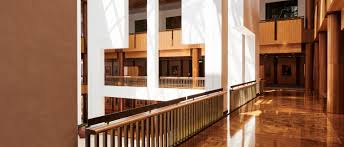Australian Parliament House architectural tours offer an extraordinary opportunity to explore one of the most iconic, symbolic, and environmentally conscious buildings in Australia. Nestled atop Capital Hill in Canberra, the Parliament House is more than a political hub—it’s an architectural marvel that seamlessly blends design, democracy, sustainability, and culture. With over 700,000 annual visitors and guided experiences attracting nearly 200,000 participants each year, the demand for these immersive tours continues to grow. Visitors walk not only through polished marble corridors and sweeping halls but also through stories of identity, innovation, and national unity. For a preview of the space, visit the official Parliament of Australia website.
The architectural philosophy of Parliament House is rooted in the democratic ideal that government should be of the people. Designed by Mitchell Giurgola & Thorp Architects, the structure embeds itself into the landscape rather than rising above it. This “building within a hill” design makes a compelling statement about humility and accessibility in governance. The Design Canberra Festival often references the structure as a landmark of civic creativity. From its layout to the selection of Australian-sourced materials, the architecture represents a conscious national narrative.
Visitors on Australian Parliament House architectural tours will immediately notice the symbolism embedded throughout. The Forecourt mosaic by Kumantje Jagamara, visible from the entrance plaza, connects modern politics with Indigenous heritage. The 81-meter steel flag mast is visible across Canberra, reflecting national pride. Inside, over 6,000 artworks line the halls, including tapestries, portraits, and sculptures. Information about these pieces can be found via National Gallery of Australia and Artbank Australia, both of which highlight public art collections and curation.
The building also offers hidden gems that fascinate architectural enthusiasts. From the vast Great Hall tapestry by Arthur Boyd—crafted from 250,000 wool threads—to the elegant symmetry of the Marble Foyer, each feature reveals another layer of the architects’ vision. Intricately designed chambers, such as the soundproof Cabinet Room and the sunlight-drenched public foyer, offer insights into form following function. Enthusiasts and scholars alike may also refer to Australian Institute of Architects for discussions on these design nuances.
Beyond its visual and symbolic allure, Parliament House is a leader in green architecture. It features a 2.5-hectare rooftop lawn planted with native grasses that reduces energy usage by up to 40%. Its sustainability record includes solar power integration, stormwater reuse systems capturing over 26 million liters annually, and waste recycling rates exceeding 75%. For those interested in the eco-conscious innovations of civic spaces, Green Building Council of Australia and Sustainable Australia provide deeper insights. You can also explore related building technologies on YourHome and EnviroDevelopment.
Whether you’re an architecture aficionado, a sustainability advocate, or a curious traveler, Australian Parliament House architectural tours are a profound journey through design, identity, and innovation. To plan your visit or learn more, check the Visit Canberra and Australia.com websites for up-to-date tour information.
Designing Democracy: The Vision Behind the Structure
Architectural Philosophy of Democracy
The Australian Parliament House, inaugurated on May 9, 1988, was designed by Mitchell/Giurgola & Thorp Architects to reflect democratic openness and national identity. It’s built into Capital Hill, symbolizing that the government is not above the people. The structure is a testament to Australia’s dedication to transparency and inclusion, and this ethos is reflected in every element, from the openness of the public areas to the materials sourced from each state and territory. As visitors embark on Australian Parliament House architectural tours, they are exposed to the ideological foundation of the building’s design.
The Architects and Their Vision
Led by Italian-American architect Romaldo Giurgola, the design aimed to integrate with the landscape rather than dominate it. Giurgola believed architecture should be a social art—his vision created a building that communicates with its citizens rather than intimidating them. With 4,700 rooms and over 250,000 square meters of floor space, the building exemplifies the balance between function and symbolic presence.
Integration with the Landscape
One of the most distinctive features is the building’s placement under a 23-meter-high grass-covered hill, which allows citizens to walk over their parliament. This concept of a “building within the hill” reinforces the democratic theme. The 81-meter stainless steel flag mast, weighing 220 tonnes, stands atop the hill as a national emblem seen from miles around.
Use of Australian Materials
Materials were carefully chosen to reflect the diversity of Australia’s natural resources. Marble from Tasmania, granite from Western Australia, and timber from Queensland all converge in this monumental space. During Australian Parliament House architectural tours, guides emphasize how these choices create a unifying national statement.
Symbolic Spatial Arrangements
The layout divides the House of Representatives and the Senate wings, symbolizing the separation of powers, while the Great Hall and central foyer foster unity and public access. The design promotes a dialogue between the government and the governed.
Architectural Symbols of Power and Identity
The Grand Design of the Forecourt
The forecourt mosaic, designed by Aboriginal artist Kumantje Jagamara (Michael Nelson Tjakamarra), spans 196 square meters and represents a central Australian desert dreaming. It’s one of the largest Aboriginal artworks in the world. The mosaic acknowledges Indigenous heritage and positions Parliament House within a deeper historical narrative. It is often a focal point in Australian Parliament House architectural tours, linking architecture to culture.
Iconography in Public Spaces
Throughout the building, national identity is reinforced through iconography—paintings of former Prime Ministers, statues of historical figures, and extensive displays of Australian art. There are over 6,000 artworks in the Parliament House Art Collection, including notable pieces from the National Gallery.
Flag Mast as a National Emblem
The stainless steel flagpole, one of the tallest structures in Canberra, holds a 12.8m by 6.4m Australian flag, weighing 15kg. It is replaced several times a year due to wear. This mast is not just a symbol of sovereignty but also an architectural marvel that draws attention in every Australian Parliament House architectural tours.
Ceiling Design and Light as Symbol
The use of natural light within the building plays a symbolic role. The central public foyer features skylights that illuminate the interior with Canberra’s sunlight, representing transparency. Even the chambers use glass ceilings to metaphorically reflect openness in governance.
Use of Color and Material to Reflect Authority
The Senate is adorned in red tones, inspired by the British House of Lords, while the House of Representatives uses green, echoing the House of Commons. These color schemes underscore the link between Australian democracy and Westminster traditions, while asserting an independent identity through distinct material and spatial use.
Guided Tours and Hidden Architectural Gems
Tour Statistics and Popularity
Over 700,000 people visit the Australian Parliament House annually, with about 200,000 participating in Australian Parliament House architectural tours. These guided experiences last 60 to 90 minutes and are conducted in multiple languages. Visitors explore both public and behind-the-scenes areas, engaging with the building’s grand narrative.
The Great Hall and Tapestry Wall
The Great Hall houses a 20-meter-wide wool tapestry created by Australian artist Arthur Boyd. This masterpiece, the largest of its kind in the Southern Hemisphere, is made from 200 colors and 250,000 wool threads. It’s a visual focal point, offering insights into the interplay between art and politics.
The Marble Foyer and Geometric Brilliance
With its 48 marble-clad columns and geometrically patterned flooring, the foyer stuns visitors upon entry. The marble—sourced from Tasmania and South Australia—symbolizes federal unity and regional contribution. The symmetry and clean lines reflect modernist precision and grandeur.
Cabinet Room and Soundproof Secrets
Though rarely accessible, some extended Australian Parliament House architectural tours may showcase the Cabinet Room. It features soundproofing technology, secret doors, and uniquely designed lighting that ensures privacy. These hidden features reveal the functional depth of the building.
The Roof Terrace and Panoramic Views
The grass-covered roof is not only symbolic but accessible. From here, visitors can take in panoramic views of Canberra’s radial layout, including the War Memorial and Mount Ainslie. The architectural alignment with Griffin’s 1912 city plan is clearly visible and discussed in most tours.
Green Roofs and Sustainability in Parliamentary Design
The Living Roof and Environmental Integration
The Parliament House boasts a 2.5-hectare green roof planted with native grasses. It acts as insulation, reducing energy consumption for heating and cooling by up to 40%. For guests on Australian Parliament House architectural tours, this sustainable feature often surprises and impresses.
Water Conservation Systems
An innovative stormwater harvesting system captures over 26 million liters of water annually. This is used for irrigation and cooling systems. The commitment to water sustainability is part of broader efforts to align governance with ecological responsibility.
Energy Efficiency Upgrades
Recent retrofitting includes LED lighting, solar panels, and a building management system that cuts annual emissions by over 2,000 tonnes of CO₂. Energy audits from 2022 show that the building now meets 4.5-star NABERS energy ratings.
Recycling and Waste Management
Over 75% of Parliament House’s waste is recycled or composted. This includes food scraps, office materials, and building waste from renovations. Such programs are often highlighted during Australian Parliament House architectural tours, demonstrating how heritage buildings can lead in environmental practices.
Climate Adaptation and Resilience
The building is designed to withstand Canberra’s extremes—from sub-zero winters to scorching summers. Materials like granite and double-glazed windows enhance thermal regulation. Additionally, new policies ensure the precinct continues evolving toward a net-zero carbon footprint by 2030.




